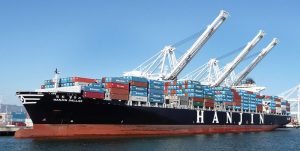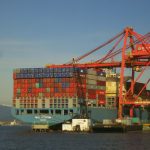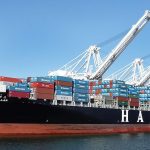Hanjin Collapses, And You Won’t Believe What Happens Next!

Hanjin Container Ship Photo by: Flickr user Ingrid Taylar
Despite the fact that Hanjin Shipping has been in financial trouble for a long time, the ocean carrier’s collapse last week is major news.
The entire shipping industry is affected by South Korea’s largest shipping company filing for court receivership. In the last blog, we covered 3 ways shippers are affected by the Hanjin collapse. We especially had U.S. shippers in mind, but the effects apply to shippers around the world.
There is this mindset that the really big shipping lines in international shipping are too big to fail. There’s actually good reason for this mindset. Operating losses in the container shipping industry were close to $20 billion in 2009. Yet somehow, all the major carriers kept operating rather than going bankrupt. Drewry called this situation of carriers somehow surviving when they should have died in bankruptcy a zombie apocalypse.
How can anyone be surprised when one of these “zombie” carriers finally collapses? I feel like we’re in a sequel to The Big Short. “There’s a bubble!”
Overnight, Hanjin’s fleet got sidelined because of the company’s receivership filing. Ships are being stranded around the world as ports refuse to take them, while many Hanjin ships are being detained. For many shippers transporting goods through Hanjin, there is no way to retrieve their cargo until the matter is settled.
Here’s the real shocker.
Many shippers are learning that their cargo, even though they did not ship through Hanjin, is stuck on Hanjin ships. Here’s how: carrier alliances.
Carrier alliances are those vessel sharing agreements between these big shipping companies that the carriers told everyone would result in better service for shippers while saving the carriers money in operating costs. Not only have carrier alliances not made service better for shippers, this one is costing its customers.
Hanjin belonged to the CKYHE alliance with Cosco, “K” Line, Yang Ming, and Evergreen. Now shippers who are customers of these other shipping lines are at risk of having their cargo on a Hanjin ship and could face serious delays and fees in order to get their cargo.
Fees on top of delays? Here’s a quick example:
When Hanjin’s court receivership went down, the WBCT terminal at the Port of Los Angeles announced Hanjin put all containers on a hold, so Hanjin containers could not be released. The Hanjin hold is being removed from containers now, but the terminal is charging an Import Delivery Fee of $376.37 per container. Who’s going to feel that fee? Shippers.
This is only one way shippers are seeing cost increases from the Hanjin collapse.
Across the industry, carriers are using the decrease in capacity caused by Hanjin’s receivership to push rate increases. We’ll continue to monitor the situation and keep you informed about the fallout of Hanjin’s collapse.





Across the industry, carriers are using the decrease in capacity caused by Hanjin’s receivership to push rate increases. Is it your view that shippers are paying not enough, too much, or just right today? or last week? or last month? or the last 60 months?
I say it is my view that shippers will pay exactly whatever the carrier charges. They will always say they are paying too much but we know from the days when the rate goes up to $4-$5k that they can pay higher rates.
From the shippers’ perspective, there’s probably no such thing as too low freight rates. However, for a long time freight rates have been too low for carriers. They’ve been struggling to be profitable, and in large part, the low freight rates is due to overcapacity. Was the decrease in capacity caused by Hanjin’s receivership really enough to cause the hike in freight rates that carriers charged? I suspect not. Those increases don’t seem to be lasting long term. Still, the carriers do need to increase rates to be profitable. While shippers enjoy low freight rates in the moment, prolonged low freight rates (like what we’ve experienced) could cause enough players to exit the game on the carriers end that competition will drop enough for freight rates to dramatically increase over a much longer period.